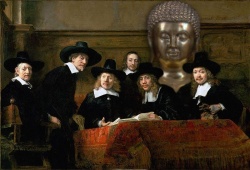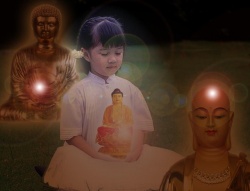Madhyamaka in Tibet
Indian Madhyamaka figures decisively in most of the Tibetan schools of Buddhist philosophy, which tend to agree in judging Madhyamaka to represent the pinnacle of Buddhist thought. There are, however, interesting historical and philosophical developments that greatly complicate this picture. For example, while the scholastic traditions of Indian Buddhist philosophy were first introduced to Tibet by the “Svātantrika” Mādhyamikas Śāntarakṣita and Kamalaśīla, many schools of Tibetan Buddhism nevertheless claim Candrakīrti’s (“Prāsaṅgika”) interpretation as authoritative – a fact partly owing, perhaps, to the influence of Atiśa in the so-called “second dissemination” of Indian Buddhism to Tibet (that is, the period during which Indian Buddhism was decisively established in Tibet, and during which the systematic translation of Indian Buddhist texts into Tibetan was brought to fruition). However, the characteristically Tibetan emphasis on “Vajrayāna” (that is, tantric) forms of practice arguably promotes greater recourse to the idiom of Yogācāra than would be encouraged by Candrakīrti. In addition, there are, as noted, philosophical reasons for qualifying some of Candrakīrti’s positions. Hence, even those Tibetan schools (such as the dGe-lugs) that most forcefully assert the authoritative character of “Prāsaṅgika” Madhyamaka tend, for example, to support their interpretation with significant studies in the Buddhist epistemological tradition – a move, as noted, definitively characteristic of the “Svātantrika” approach.
The attempt thus to wed Madhyamaka to the philosophical project of Dignāga and Dharmakīrti is worth appreciating not only because it is intrinsically interesting, but because, particularly in the United States in the latter part of the 20th century, a great many modern interpreters of Indian Madhyamaka have been influenced by characteristically Tibetan appropriations of this tradition. While this has arguably led to some distortions in the exegesis particularly of Candrakīrti’s texts, there is much to recommend the Tibetans’ systematic (as opposed to historical) presentation of Madhyamaka in relation to the other schools of Indian Buddhist philosophy. As indicated, a distinctive feature of characteristically Tibetan presentations of Buddhist philosophy is the use of doxographical digests elaborating what are called “established conclusions” (grub mtha’; this translates the Sanskrit siddhānta).
On this model, the various schools of Indian Buddhist philosophy (principally consisting, according to such presentations, in the two “Ābhidharmika” schools of the Vaibhāṣikas and Sautrāntikas, and the two “Mahāyāna” schools of Yogācāra and Madhyamaka) are represented in an ascending hierarchy of progressively more refined positions, the proper understanding of each of which requires understanding its predecessors. Ascent through the hierarchy is characterized, most basically, by the progressive elimination of ontological commitments: the two Ābhidharmika schools divide over the question of what are to be admitted as “dharmas” qualifying for inclusion in a final ontology; Yogācāra further pares down this list to nothing but mental events; the “Svātantrika” Mādhyamikas are represented as retaining only the vestigial ontological commitments that are thought to be entailed by their characteristic deference to the dialectical tools of epistemology; until, with the “Prāsaṅgika” iteration of Madhyamaka, we arrive at the school of thought for which the set of “ultimately existent” (paramārthasat) phenomena is an empty set.
The effect of this is to throw our attention back to the only “set” of existents with any remaining content: the conventionally described world, now understood as ineliminable. Hence, on this view, there is the avoidance of (what Mādhyamikas are always trying to eschew) the extreme of nihilism or “eliminativism” (ucchedavāda); but there is also the (constitutively Buddhist) avoidance of the extreme of “eternalism,” insofar as the effect of cultivating the Mādhyamika insight only as the culminating stage in a progression is (it is claimed) to have driven home the realization that the self exists (like everything “conventional”) only relatively or dependently. Once the project of a privileged level of description has been abandoned, the “common-sense realism” that remains can be seen to differ from that of the unenlightened “by virtue of its being adopted in full cognizance of the progression through the intervening stages” (Siderits 2003, 185).
The same insight is reflected in the basic monastic curriculum of dGe-lugs-pa monasteries, which is structured around five topics defined by representative Indian texts: The Vinaya, or Buddhist monastic code, as represented by the Vinaya Sūtra of Guṇaprabha; Abhidharma, as represented by the Abhidharmakośa of Vasubandhu; logic and epistemology, as represented by the Pramāṇavārttika of Dharmakīrti; Madhyamaka, as represented by Candrakīrti’s Madhyamakāvatāra; and the stages on the path to enlightenment, as represented by the Abhisamayālaṃkāra attributed to Maitreya. In this way, the study of the Madhyamaka tradition of Buddhist philosophy comes only in the context of an overarching education in a complete Buddhist world-view, such that characteristically Mādhyamika teachings concerning “emptiness” are – like the Prajñāpāramitā Sūtras whose retrieval by Nāgārjuna was thought to introduce Mahāyāna as representing the Buddha’s definitive teaching – made intelligible by the necessarily propaedeutic earlier teachings. Above all, it is the finally ethical character of Mādhyamika thought that is encouraged by this pedagogical system; for the characteristically Mādhyamika claim that “all dharmas are empty” – that, in other words, Abhidharma’s reductionist account of the person cannot finally be made coherent – cannot be understood as nihilistic if it has been made clear that the upshot of it is to return our attention to the irreducibly conventional world in which persons live and suffer.
Tibetan tradition preserves, however, not only a model for the integration of Madhyamaka philosophy into a structured set of transformative religious practices, but also a great deal of innovative and sophisticated philosophical elaboration of Mādhyamika thought. For example, the prolific scholar Tsong-kha-pa (1357-1419) – originator of the influential reformist school that would style itself the “dGe-lugs” (“virtuous way”) – did much to integrate the Prāsaṅgika Madhyamaka of Candrakīrti with the understanding and teaching of Buddhist epistemology stemming from Dharmakīrti. Tsong-kha-pa’s works (such as the massive Lam rim chen mo, “Great [treatise on] the Stages of the Path”) also bring considerable sophistication to bear on the question of how Madhyamaka ought to be understood in relation to Yogācāra. Critics of Tsong-kha-pa – such as, notably, the Sa-skya-pa scholar Go-ram-pa bSod-nams seng-ge (1429-1489) – stridently condemned his confidence that the discourse of epistemology could bring Mādhyamika analysis into contact with ultimate reality. On Go-ram-pa’s reading, such confidence amounts to the claim that the discursive thought that understands “ultimate truth” is itself ultimately true – which is to confuse the (necessarily conventional) activity of thinking about ultimate truth with what it is that such thought is about. Go-ram-pa claims that Tsong-kha-pa’s account of Madhyamaka entails the nihilistic conclusion that what is ultimately true is simply what is conventionally true. This Tibetan debate, then, recognizably addresses the perennially vexed issues that go to the heart of Madhyamaka: those concerning how we are to understand the relation between ultimate and conventional truth, in the context of a claim to the effect that “the ultimate truth is that there is no ultimate truth.”



